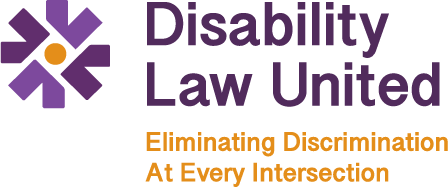Disability Law United is pleased to announce a new resource called Inmates with Disabilities: Know Your Rights. This resource provides an overview of the rights of disabled inmates and gives examples of potential violations. Please share it with anyone who may benefit from it. We greatly appreciate the work of our summer intern, Jordan Staley, on this project and wish him all the best as he begins his third year at Denver Law. A more detailed discussion of the rights of disabled inmates follows below.
Applicable Laws
Title II of the Americans with Disabilities Act (ADA)[1] and Section 504 of the Rehabilitation Act (Section 504)[2] protect people, including inmates of jails and prisons, from disability discrimination. This means jails and prisons[3] must not discriminate against inmates because of their disability and must give disabled inmates equal access to the programs, services, and benefits of the facility. So, for example, a jail cannot provide classes only in a building that is physically inaccessible to wheelchair users. Similarly, prisons cannot segregate blind inmates by automatically housing all of them in the medical unit. Individuals with a relationship or association with a disabled person are also protected by these federal laws. So, jails and prisons also cannot discriminate against family members and friends of disabled inmates or disabled family members and friends of nondisabled inmates.
Changes Needed Due to Disability
Sometimes disabled inmates need the facility to make a change to allow them to fully participate in its programs, services, or benefits. The ADA and Section 504 require prisons and jails to make such changes (referred to as accommodations or modifications) as long as they are reasonable. For example, an inmate with a mobility disability may need additional time to travel from their cell to the cafeteria. Or, an inmate with a life-threatening peanut allergy may need their food prepared in a peanut free area of the kitchen. In most cases, it is an inmate’s responsibility to request these reasonable changes and, unless it’s obvious, explain why the change is necessary due to their disability.
Effective Communication
The ADA and Section 504 require correctional facilities to communicate as effectively with inmates with disabilities as with others. Prisons must provide auxiliary aids and/or services when necessary for effective communication. Auxiliary aids/services include sign language interpreters, videophones, Braille documents, audio documents, captioned videos and TV, and explanations of documents. Prisons must tailor an auxiliary aid/service to an inmate’s individual needs and give primary consideration to an inmate’s requested mode of communication. Providing an inmate handbook in only written English will not result in effective communication for a blind inmate or a deaf inmate whose primary language is ASL. Neither will providing a Braille document to someone who is blind but does not read Braille. It is similarly ineffective for a jail to provide a TTY to a deaf inmate whose primary language is ASL. A videophone will be required for effective communication. (Link to our prior videophone article)
Exceptions
Keep in mind that prisons are not required to provide accommodations/modifications or auxiliary aids/services that require a fundamental alteration or impose an undue burden on the facility. Prisons may also exclude a disabled inmate from a program or service if his participation would pose significant health and safety risks or a direct threat to others.
If you or someone you know is being discriminated against in jail or prison, contact Disability Law United at info@creeclaw.org or 303.757.7901 for possible help.
[1] 42 U.S.C. § 12131.
[2] 29 U.S.C. § 794(a).
[3] Throughout the remainder of this article, the terms prison, jail, and correctional facility will be used interchangeably.

I was in prison I have a disability mobility.
I have a metal raw and pins on femur and ankle permanent damage. I was lower bunk. Because overcrading I got moved around to top bunks up stairs. Was very deficult for me to get down or climb up. Due to that my ankle hurts more. Also they had in file I need a caine. Special shoes. They never give anything. They didn’t care if I would get hurt. Plus on raining days water every in the cell and hallway.